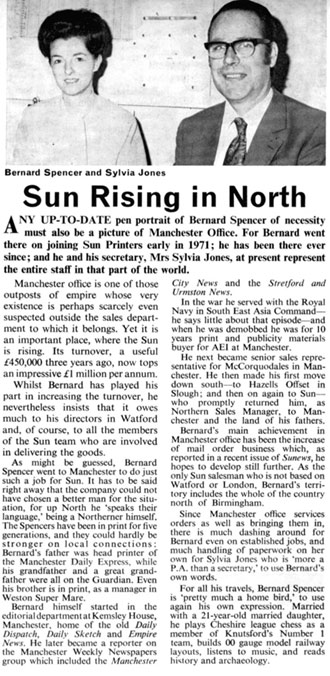Sun Printers Manchester Office
by Bernard Spencer
I was Sun Printers’ northern sales manager, based in Manchester, from January 1, 1971 until June 30, 1977, when the office was closed down and both I and my secretary, Mrs Sylvia B. Jones, were made redundant.
In 1968 I had joined Hazell’s Offset in Slough as a sales executive and reported to David J. Nichols, their sales director. In December 1970 he informed me that he was joining Sun Printers in the coming January as their sales director. He wished me to join his sales force to manage the Manchester office, as I was familiar with mail order work, having already procured this type of print for Hazells. However, it was not to be for David, as apparently there had been some misunderstanding over his contract and he never joined Sun. I, however, took over the Manchester office as from January 1, 1971, and reported to Russell Pearce, Sun’s sales director until the following month, when the post was filled by Michael E.J. Knowles, as reported in Sunews New Series, no. 22.
Sylvia Jones became my secretary shortly after my taking over the office and was with me the whole time until we were both made redundant in June 1977.
The office at first was in the Milne Building, Mosley Street. We had to move from there after a few months due to redevelopment. Our next office was in an old building in Whitworth Street, and we had to vacate this after about a year because it was going to be demolished. It is still there today! The final office was Churchill House, Talbot Road, Old Trafford, adjacent to the famous cricket ground.
In Manchester I took over a small number of existing accounts, consisting of a few 32-page sections of Great Universal Stores mail order catalogue, and Parker’s Dutch Bulbs brochure. That was all. During that period web offset was making great strides, securing most of the medium-to-long-run work, apart from mail order. And some of this work was also being lost to the new post-war German gravure houses. Web offset make-ready time was considerably shorter than gravure’s, and this didn't improve until the Sun acquired – and became experienced with – the Helioklischograph [cylinder engraving] units. Meanwhile, web offset could take advantage of thinner paper stock (thus reducing costs) and still achieve excellent results; it couldn't match gravure for really long runs, however, due to the limited number of units on the presses. Nevertheless, web offset had sufficient capability to grab the lion's share of the medium-to-long runs of holiday and tours brochures hitherto printed by gravure. Had the Helioklischographs been available at Sun earlier, Sun could have capitalised on the fast output of its big multi-unit presses. All of this inevitably had a marked effect on my sales activities due to the frequent rejection of our quotations. However, my prior connections with Great Universal allowed me, after a short time, to build their account up quite considerably from £400,000 to over £1 million as reported in the two-page issue of Sunews no. 38 of April 1974 (an issue of only a single sheet, due to the crisis 3-day week).
It must be remembered that there were only two of us at Manchester, and three months of the year we didn’t see one another due to holidays (which we had to take separately), so it will be appreciated that we were always busy. Sylvia and I were in constant touch with Mike Dix and Helen Coppen in the production office and had to see to Allen Bush of the gravure process engraving department when he arrived in Manchester by train with the proofs of the sections for Great Universal Stores to check and correct where necessary. In addition to this, I had to pass on any adverse comments concerning production delays and/or quality to Gerald Mowbray, production director, and on the odd occasion to Roy Smith, who was managing director during most of my service. We also were in regular touch with Ken Mott, chief estimator, and his staff, who gave us good service in supplying quotations.
By the time of the cost-cutting operation at the end of June 1977, carried out by managing director Clive Bradly, when we were made redundant, we in Manchester Office were handling up to nine 48-page sections twice a year, at roughly £1.4 million (1970 prices).
Norman Grimshaw, who was head of the catalogue production department at Great Universal, was also made redundant at the same time as myself, and along with Michael Knowles I attended a farewell party at a local pub. It was there that I was told unofficially that Sun would only be given three 48-page sections for the next issue of the GUS catalogue. It was a sad ending to a happy episode in our lives. Fortunately, both Sylvia and I very soon secured senior positions elsewhere, she outside printing; I continued to sell print until I retired at sixty-six.

Reproduced from Sunews, New Series, No. 38, April 1974.